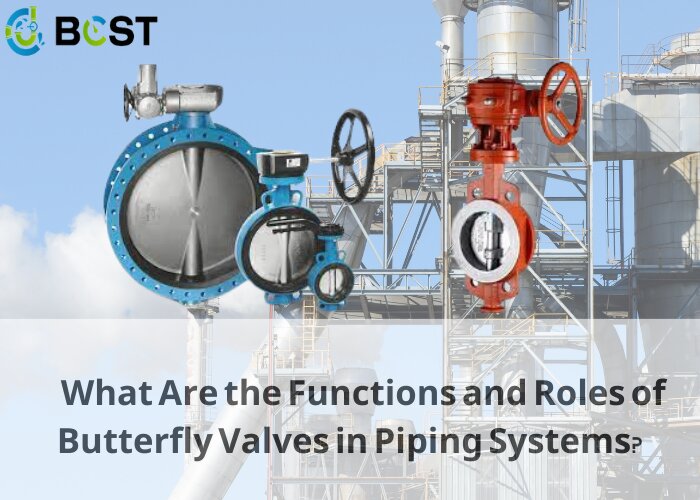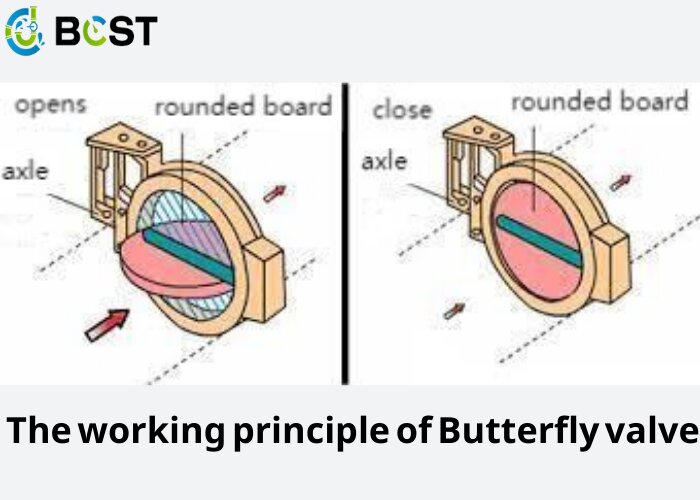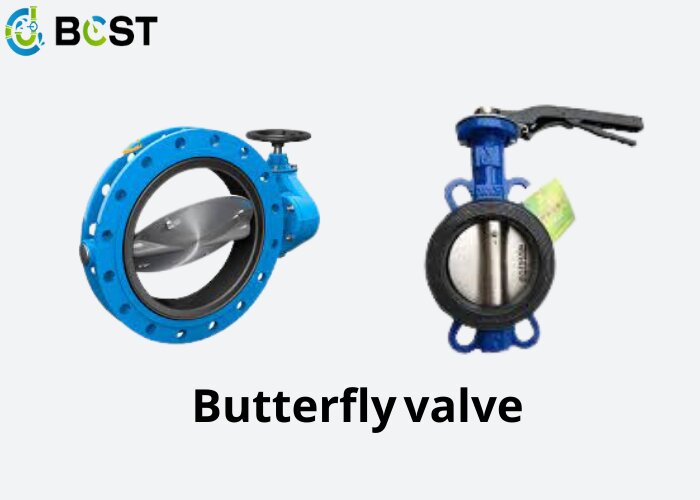
Butterfly valves are essential components in piping systems and are pivotal in regulating fluid flow. In this blog, we’ll dive into butterfly valves’ fundamental functions and significance, highlighting their crucial role within piping systems.
Butterfly valves is quarter-turn flow control or isolation devices used in pipe systems for rapid shut-off. They have compact, lightweight designs that improve flow coefficients, limit pressure drops, and enhance pressure recovery.
The opening and closing of the valves for isolation or throttling service is controlled by a centrally located disc attached to a rod or shaft flowing through it and externally coupled to an actuator. Turning the actuator aligns the disc perpendicular or parallel to the flow direction.
Valve discs have the same radial dimensions as the bore and are always present in the flow, causing a little pressure decrease in the system.
Butterfly valves are classed depending on the disc closure type and the design of the valve body ends.
The disc closure type:
- Concentric valves with stems that are parallel to the disc’s centerline. It is a rubber-seated, zero-offset valve that is often employed in low-pressure flow applications.
- Eccentric valves have the stem offset from the disc’s midline. They are high-performance valves with strong seals that prevent jamming due to fast closing. Eccentric valves come in single-offset, double-offset, and triple-offset configurations.
The design of the valve body's ends:
- Wafer-type valves are sandwiched between two pipe flanges and fastened together by bolts that span the width of the valve body.
- Lug-type valves include threads on the outside sides of the valve body that enable for a bolt-only attachment of the valve to the pipe flanges.
- Flanges on both ends of the valve body define a double-flanged butterfly valve. These valves are simple to install and can be matched to existing pipe designs.
- For high-pressure applications, butt-welded butterfly valves are essential. Welding forms a lasting bond between the valve and the neighboring pipes.

Butterfly valve actuation accelerates the opening and closing properties. The use of valves improves the steady, incremental flow of fluids in a piping system. An actuator generates the torque required for optimal valve functioning. For industrial butterfly valves, the following actuators are available:
Manual valve operation
These are simple, hand-operated actuators that regulate the position of the stem and disc with a wheel, crank, or lever. They are basic, low-cost valve operating devices that are ideal for remote pipe systems without power. A geared system is used in some large valves to boost torque. Advanced, gear-driven actuators contain analog indications that correspond to the approximate positions of the discs.
This category of valve operation is limited to use with small-sized valves. Their operational speed could be higher, making them unsuitable for critical pipe systems.
Electric valve actuator
To enable remote valve operation, the actuator employs a bi-directional motor. The adaptable actuation system includes a gearbox that reduces motor speed while boosting torque. Electric actuators are low-maintenance, easy-to-install devices that are often employed for process control in non-critical and light-duty modulation operations. The valve’s real position is replicated as a voltage or current signal. They use less energy and run silently.
Some electric actuators contain limit switches that initiate motor stoppage when the valve is closed or open. Processes with a reliable power source are the only ones that can be used.
Pneumatic valve actuators
Pneumatic actuators can be single-acting or double-acting. Their designs incorporate several apertures for pressurized air entrance and exit. When air enters the actuator’s chamber, it causes the piston/plunger to move linearly or rotaryly. It produces a rotating or lifting torque on the stem, forcing the disc to open or close and controlling fluid flow. The actuators may include solenoids that respond to electrical signals to control the actuator’s position.
These actuators have a compact design and are lightweight and economical. Their quick reaction time suits them for repeatedly throttled pipelines, such as industrial gas service, conveying slurry, and steam service. They only function when there is an external source of compressed air.
Hydraulic valve actuator
Large turning forces are required for heavy-duty valves, such as major steam valves. Such valves require hydraulic actuators, available as single-acting (spring return) or double-acting actuators that use fluid pressure to open or close valves. The absence of fluid pressure maintains the valve closed for single-acting actuators. The hydraulic force supplied by a fluid (hydraulic oil or sometimes water) pulls the piston upwards to open the valve as upstream pressure builds up. Reversing these conditions expels the hydraulic fluid in the opposite direction, closing the valve. Double-acting hydraulic actuators have an internal hydraulic pump that adjusts the direction of the hydraulic fluid to meet the flow conditions of the pipeline.
Smaller butterfly valves use hydraulic actuators with solenoids to regulate the plunger’s linear motion. Hydraulic actuators are a cost-effective way to operate huge valves automatically or semi-automatically.

3.Valve actuator selection criteria
When selecting an actuator for butterfly valves, the system configuration must be considered. The valve body should have mounting flanges that fit, the stem should be able to be coupled with an actuator, and the bolt patterns on the flange and the actuator housing should match. Other technical considerations are as follows:
Cycling requirements
The duty cycle is the ratio of the time it takes an actuator (on time) to complete valve actuation (off time). Since valves are mechanical devices, frequent operation leads to a build-up of heat, which affects the sealing properties of the valve and leads to damage to actuator components. The duty cycle of an actuator varies based on how frequently the valves are activated. Hydraulic valve actuators used in often cycled, high-pressure pipe systems can have up to 100% duty cycle. However electric actuators used for shorter periods can have as low as 25% duty cycle.
Actuator speed
The speed of actuators depends on system requirements. Chemical processes, for example, require fast-acting (hydraulic or pneumatic) actuators since they are often cycled, high-pressure, and critical. A slow-acting actuator, on the other hand, is ideal for mixing tasks, particularly when introducing a cold fluid into a warm system.
Nature of working media
Actuators are coupled to the stem of a valve through an adaptor or mounting on the body of the valve. The actuator is exposed to the working medium due to coupling mechanisms. It is critical to determine whether the working fluid is corrosive, poisonous, or gaseous. To prevent leaks or damage, the actuator’s body must be made of a similar or stronger material than the valve.
Actuator type, design, and redundancy
System failures occur in flow operations. Actuator systems must have a particular level of redundancy to provide flow control while maintaining the system’s safety standards. To prevent contamination, a fail-open butterfly valve with a hydraulic actuator, for example, requires a spring return mechanism.
Cost and Maintenance
Each valve actuator comes with a specified lifespan. By comparison, pneumatic actuators last longer than their electric counterparts. Several maintenance interventions are required during the actuator’s operational life. The price of maintaining or replacing the actuator should be affordable. The cost of obtaining and maintaining ancillary equipment is another factor to consider.
4.Conclusion
In conclusion, butterfly valves are indispensable in the world of piping systems, offering efficient control over fluid flow. We’ve explored their fundamental functions and actuation methods, shedding light on the critical role they play in various applications. By understanding their role and selecting the right actuation method based on system requirements, you can ensure smooth and reliable operation while maintaining safety and cost-effectiveness in your piping systems.
BCST Group is committed to the research development and manufacture of various types of valves, welcome to consult and inquire, we will be happy to serve you.Please go to this URL (www.bcstgroup.com) to browse.






